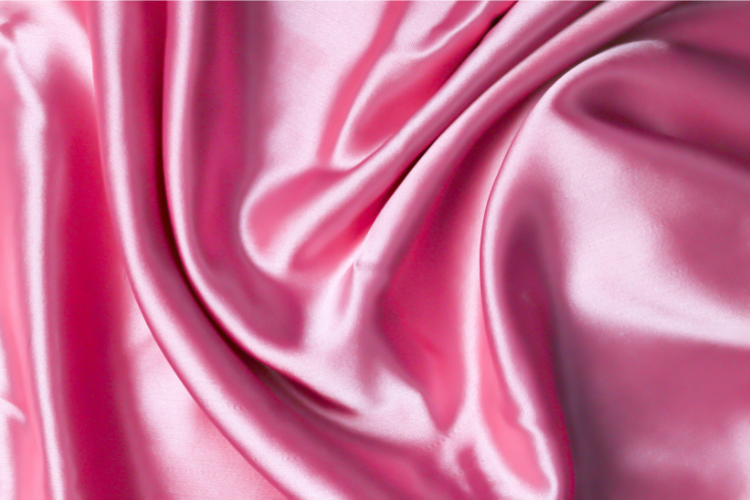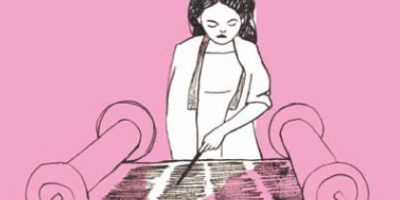
A Sea of Pink Kippot
“Why can’t I have pink?” my daughter insisted, while I cringed in dismay. This was the last thing I would have expected, and only reinforced my certainty that my daughter had no idea how momentous this event would be, nor the generations of struggle that had paved her way.
I had made sure that she grew up in a fully egalitarian shul, and even that she have her own distinct bat mitzvah although she and her brother are only ten months apart in age. I knew only too well that in a joint ceremony and celebration, the boy would get most of the attention. So I chose to be the world’s longest-duration b’nei mitzvah mom, planning and orchestrating two major events in under a year.
My daughter’s bat mitzvah parasha was Nitzavim, the one near the end of Torah with the dramatic scene where the Israelites are about to enter the land, where Moses points to the two mountains in front of them and says, “I call heaven and earth to witness you today: I have put before you life and death, blessing and curse—therefore choose life!” (Deut. 30:19). The original text has a clear meaning related to assuming and following God’s laws, and a moral underpinning calling for righteous action. While these were all present in the context of the shul itself, and elaborated by my daughter in her dvar Torah, there was also a much more simple meaning present that day.
On her mother’s side my daughter is the grandchild of two Shoah survivors (my parents), each the sole survivor of large extended families. For them too, and for me when deciding to have and raise Jewish children, there was a very clear injunction to ‘choose life’ in the face of death, destruction, and despair, and in opposition to fear, hiding, and assimilation. Indeed, the birth rate among the survivors in the DP camps after the Shoah was the highest in recorded history. In the face of overwhelming mass genocide, the Jewish DPs did not choose revenge or despair; rather, they chose life. The passing of the Torah down the generations at that bat mitzvah had special resonance, as it went from the arms of my mother [my father had already died] through mine to my daughter, a journey from mass genocide through refugee status to new life, across continents and an ocean.
But my daughter’s bat mitzvah also marked a new kind of turning point.
The phrase “I place before you life and death, choose life” is a classic example of a ‘merism’, a figure of speech that is used frequently in the Bible, where two parts or elements are used to denote the whole. For example, at the very start of Bereshit when God creates “the heavens and the earth,” the two parts indicate that God created the entire universe.
When the Torah states that God puts life and death before us, our tradition is telling us that every choice we make from birth to death matters. And part of choosing life is moving forward, into a future that is unknown, as the Israelites are on the brink of moving forward into their new life as a nation, and creating new life in that future.
The first female to mark her bat mitzvah in either of her family lines, the first girl to read Torah on the bimah in the age-old ritual heretofore reserved for the men and boys, my daughter joined her friends in finding the whole exercise normal, almost boring. Unlike her mother or grandmother, she’d grown up seeing women on the bimah, had no sense of how strange and new it was for girls to do this.
My mother was coming from the other side of the continent, and her special contribution was to order and bring the souvenir kippot usually bearing the names of the b’nei mitzvah, or the bride and groom at a wedding. It used to be customary among older generations to save these souvenir kippot; sideboard drawers in certain kinds of homes would be filled with satin kippot, the colors changing with the fashion.
My daughter had something new in mind. Pink was her favorite color at the time, and she wanted pink kippot for her day. Nothing could have appalled me more. It was hard enough for women to be taken seriously, especially when performing the traditional male religious roles.
Pink carried all the connotations of feminine frivolity, the color of ribbons and bows, of Barbie dolls, of dreaded froufrou. It may be difficult, in this season of the Barbie blockbuster movie, to grasp just how derided Barbie was in the era of second-wave feminism, or all that the color pink carried as connotation—none of it good.
Where was the gravitas, the high seriousness required for the day? My mother had other concerns: “But it’s not done,” she worried, “I’ve never seen pink kippot. Why not blue, or white, a nice tradi- tional color?” My daughter was insistent. She had always known her own mind. “What’s wrong with pink?” she insisted, causing me to realize that I had no real answer, only prejudices based on negative stereotypes. Something important shifted for me, in the way I understood convention, power, and the meaning of freedom.
The day came. A day when, for the first time anyone could remember, the synagogue was a sea of pink, every head of every man and woman covered in pink silk shantung. I listened to my daughter chant the ancient words in their ancient melodic modes. The Torah portion for that day was towards the end of the final fifth book, the point where Moses and the Israelites have finally reached the end of the forty years of wandering in the wilderness, are about to enter the land. The portion where Moses addresses the people, before they enter into their new life, while he must stay behind. The commentators explain Moses’ exclusion in psychological terms—only those born in freedom can enter the future. I listened to my daughter’s strong capable voice, as I looked out over the pink synagogue.
I realized that I, too, was at a threshold that I couldn’t really cross; the next steps would be made by my daughter and her generation. My sense of the color pink shifted. My daughter soon decided that black was her favorite color…and so it remains, two decades later.
To this day, there are women of a certain age, in that small but feisty Jewish community on an island in the Pacific, who remember and speak of that momentous day when the shul was a sea of pink, for the first time ever.
Kitty Hoffman is completing a memoir about her medieval Provencal ancestor, the father of kabbalah, and the weight of her Holocaust legacy.



